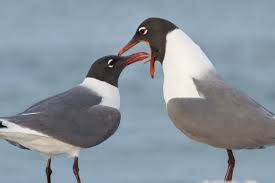Stamp: Sailboat on Lake Balaton, Gull (Larus sp.) (Hungary 1959)
Sailboat on Lake Balaton, Gull (Larus sp.) (Hungary 1959)
15 July (Hungary ) within release Lake Balaton (1959) goes into circulation Stamp Sailboat on Lake Balaton, Gull (Larus sp.) face value 30 Hungarian fillér
| Stamp Sailboat on Lake Balaton, Gull (Larus sp.) in catalogues | |
|---|---|
| Michel: | Mi: HU 1609B |
| Philatelia Hungarica Catalog: | PHu: HU 1674V |
Stamp is vertical format.
Also in the issue Lake Balaton (1959):
- Stamp - Tihany face value 20;
- Stamp - Ferry "Tihany" face value 70;
- Stamp - Hévíz and water lily face value 1;
- Stamp - Sailing boat "Saturnus" and fishermen statue face value 1.70;
- Stamp - Couple swimming & sun face value 60;
- Stamp - Ferry "Tihany" face value 70;
- Stamp - Fishermen, Fish face value 1.20;
- Stamp - Hévíz and water lily face value 1;
- Stamp - Sailboat on Lake Balaton, Gull (Larus sp.) face value 30;
- Stamp - Sailing boat "Saturnus" and fishermen statue face value 1.70;
- Stamp - Tihany face value 20;
- Stamp - Tourists and ferry "Beloiannisz" face value 2;
- Stamp - Vintager and lake Balaton face value 40;
- Stamp - Couple swimming & sun face value 60;
- Stamp - Ferry "Tihany" face value 70;
- Stamp - Hévíz and water lily face value 1;
- Stamp - Tihany face value 20;
- Stamp - Vintager and lake Balaton face value 40;
Stamp Sailboat on Lake Balaton, Gull (Larus sp.) it reflects the thematic directions:
Animals are multicellular, eukaryotic organisms of the kingdom Animalia (also called Metazoa). All animals are motile, meaning they can move spontaneously and independently, at some point in their lives. Their body plan eventually becomes fixed as they develop, although some undergo a process of metamorphosis later on in their lives. All animals are heterotrophs: they must ingest other organisms or their products for sustenance.
Birds (Aves), a subgroup of Reptiles, are the last living examples of Dinosaurs. They are a group of endothermic vertebrates, characterised by feathers, toothless beaked jaws, the laying of hard-shelled eggs, a high metabolic rate, a four-chambered heart, and a strong yet lightweight skeleton. Birds live worldwide and range in size from the 5 cm (2 in) bee hummingbird to the 2.75 m (9 ft) ostrich. They rank as the class of tetrapods with the most living species, at approximately ten thousand, with more than half of these being passerines, sometimes known as perching birds. Birds are the closest living relatives of crocodilians.
Gulls, or colloquially seagulls, are seabirds of the family Laridae in the suborder Lari. They are most closely related to the terns and skimmers and distantly related to auks, and even more distantly to waders. Until the 21st century, most gulls were placed in the genus Larus, but that arrangement is now considered polyphyletic, leading to the resurrection of several genera.An older name for gulls is mews, which is cognate with German Möwe, Danish måge, Swedish mås, Dutch meeuw, Norwegian måke/måse, and French mouette, and can still be found in certain regional dialects
A lake is a naturally occurring, relatively large and fixed body of water on the Earth's surface. It is localized in a basin or interconnected basins surrounded by dry land. Lakes lie completely on land and are separate from the ocean, although they may be connected with the ocean by rivers, such as Lake Ontario. Most lakes are freshwater and account for almost all the world's surface freshwater, but some are salt lakes with salinities even higher than that of seawater. Lakes vary significantly in surface area and volume.
A modern sailing ship or sailship is any large wind-powered vessel. Traditionally a sailing ship (or simply ship) is a sailing vessel that carries three or more masts with square sails on each. Large sailing vessels that are not ship-rigged may be more precisely referred to by their sail rig, such as schooner, barque (also spelled "bark"), brig, barkentine, brigantine or sloop. There are many different types of sailing ships, but they all have certain basic things in common. Every sailing ship has a hull, rigging and at least one mast to hold up the sails that use the wind to power the ship. The crew who sail a ship are called sailors or hands. They take turns to take the watch, the active managers of the ship and her performance for a period. Watches are traditionally four hours long. Some sailing ships use traditional ship's bells to tell the time and regulate the watch system, with the bell being rung once for every half hour into the watch and rung eight times at watch end (a four-hour watch). Ocean journeys by sailing ship can take many months, and a common hazard is becoming becalmed because of lack of wind, or being blown off course by severe storms or winds that do not allow progress in the desired direction. A severe storm could lead to shipwreck, and the loss of all hands. Sailing ships are limited in their maximum size compared to ships with heat engines, so economies of scale are also limited. The heaviest sailing ships (limited to those vessels for which sails were the primary means of propulsion) never exceeded 14,000 tons displacement. Sailing ships are therefore also very limited in the supply capacity of their holds, so they have to plan long voyages carefully to include many stops to take on provisions and, in the days before watermakers, fresh water.
A ship is a large watercraft that travels the world's oceans and other sufficiently deep waterways, carrying passengers or goods, or in support of specialized missions, such as defense, research and fishing. Historically, a "ship" was a sailing vessel with at least three square-rigged masts and a full bowsprit. Ships are generally distinguished from boats, based on size, shape and load capacity.





